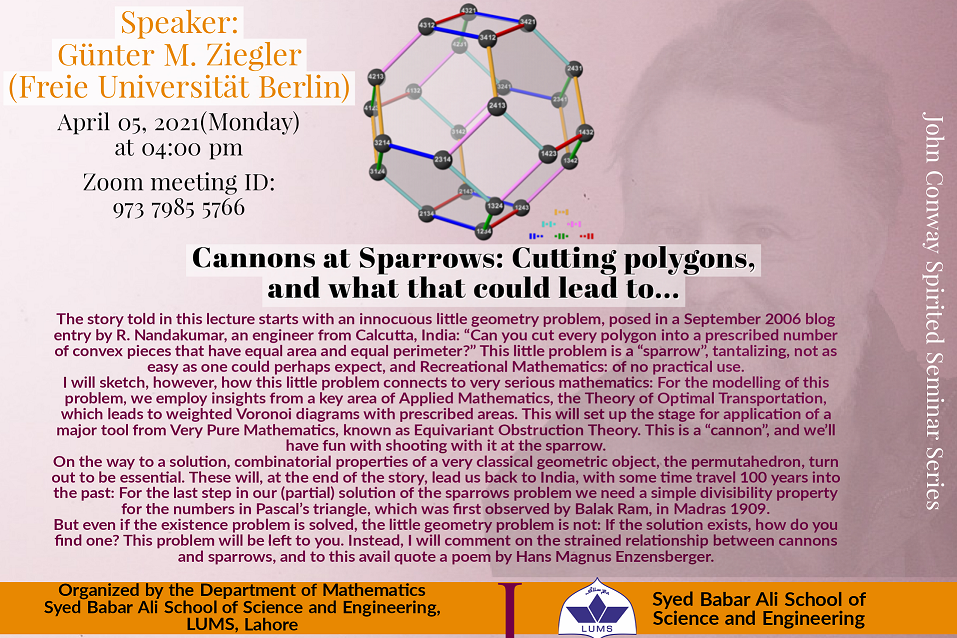
Cannons at Sparrows: Cutting Polygons, and What That Could Lead To..
I will sketch, however, how this little problem connects to very serious mathematics: For the modelling of this problem, we employ insights from a key area of Applied Mathematics, the Theory of Optimal Transportation, which leads to weighted Voronoi diagrams with prescribed areas. This will set up the stage for application of a major tool from Very Pure Mathematics, known as Equivariant Obstruction Theory. This is a “cannon”, and we'll have fun with shooting with it at the sparrow.
On the way to a solution, combinatorial properties of a very classical geometric object, the permutahedron, turn out to be essential. These will, at the end of the story, lead us back to India, with some time travel 100 years into the past: For the last step in our (partial) solution of the sparrows problem we need a simple divisibility property for the numbers in Pascal’s triangle, which was first observed by Balak Ram, in Madras 1909.
But even if the existence problem is solved, the little geometry problem is not: If the solution exists, how do you find one? This problem will be left to you. Instead, I will comment on the strained relationship between cannons and sparrows, and to this avail quote a poem by Hans Magnus Enzensberger.
Professor Günter M. Ziegler will talk about a “sparrow” problem posed in a September 2006 blog entry by R. Nandakumar, an engineer from Calcutta, India: “Can you cut every polygon into a prescribed number of convex pieces that have equal area and equal perimeter?” For the modelling of this ‘sparrow’ problem, he will then make connections to a very serious area of Applied Mathematics, the Theory of Optimal Transportation, which leads to weighted Voronoi diagrams with prescribed areas. This will set up the stage for application of a major tool (“cannon”) from Very Pure Mathematics, known as Equivariant Obstruction Theory to model the ‘sparrow’ problem.
Ziegler was awarded the one million Deutschmark Gerhard Hess Prize [de] by the Deutsche Forschungsgemeinschaft (DFG) in 1994 and the 1.5 million Deutschmark Gottfried Wilhelm Leibniz Prize, Germany's highest research honor, by the DFG in 2001. He was awarded the 2005 Gauss Lectureship by the German Mathematical Society. In 2006 the Mathematical Association of America awarded Ziegler and Florian Pfender its highest honor for mathematical exposition, the Chauvenet Prize, for their paper on kissing numbers. In 2006 Ziegler became president of the German Mathematical Society for a two-year term. In 2009, the European Research Council (ERC) awarded Ziegler one of the ERC Advanced Grants in the amount of 1.85 million Euros. In 2012 he became a fellow of the American Mathematical Society. In 2013 Ziegler was granted the Hector Science Award and became a member of the Hector Fellow Academy. Since 2016 Ziegler has become the chair of the Berlin Mathematical School. In 2018 he received the Leroy P. Steele Prize for Mathematical Exposition (jointly with Martin Aigner).
Please join us virtually via zoom.
Zoom Meeting link: https://zoom.us/j/97379855766
Meeting ID: 973 7985 5766; Passcode: 146928
Please see the Seminar series link below for details:
https://sites.google.com/view/conway-spirited-math-seminars/home

